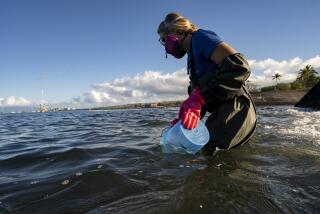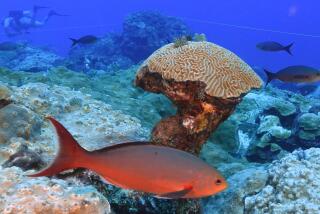A Day In The Life Of Mother Earth : A Reef in Luzon : ‘We get less fish every year because there are too many fishermen.’ Romeo Castil, <i> fisherman </i>
- Share via
BOLINAO, Philippines — * The Problem--Biodiversity
* The U.N. View--”About one-third of all fish species lie in coral reefs found near coasts--the ‘tropical forests of the oceans’. . . . Half the world’s population depends on fish for its main source of food.”
* The Case Study: Philippines--Explosives and cyanide used by local fishermen have badly damaged the nation’s reefs, considered the most diverse in the world.
Dawn breaks on this fringing reef with the distant thunder of dynamite fishermen. In five hours, 41 blasts rumble across the rippling waves as illegal explosives tossed like depth charges from canoes kill schools of fish and devastate the fragile coral gardens below.
At midmorning, two boats crammed with divers set out to seek brilliantly colored and wildly shaped tropical fish for the overseas aquarium trade. One diver later explains how: Holding his breath underwater, he squirts a weak solution of sodium cyanide at the waving anemones and coral fingers where the fish hide. Stunned, they float belly up in the current. The divers easily net their prey as the white cloud of poison settles on the living coral.
Fishermen working from outriggers splash the lagoon with long poles to scare rabbit fish into gill nets. Boys repair elaborate fish corrals and traps, or patiently jig hook and line off tiny bamboo rafts. Young men dive long hours deep underwater, spearing trigger fish by hand and sucking air from a “hookah,” a hose linked to a compressor designed to pump tires, not lungs.
By late afternoon, as the tide falls, hundreds of women and children glean the exposed reef flats, searching amid the coral and grass for fish, clams, sea cucumbers, sea urchins and other foodstuffs, plus shells. Cleaned and polished, the massive tritons and golden cone shells are eventually sold as curios in Florida and Hawaii.
All through the night, fishermen hang bright Coleman lanterns from their boats to attract fish. Others dive all night. And at sunrise, it starts again, a nonstop cycle in which thousands of people make a marginal and dangerous living off this single reef--and increasingly destroy it.
“We get less fish every year because there are too many people, too many fishermen,” sighed Romeo Castil, 52, who lives in Silaqui, a fishing village of 36 families on a tiny island with no fresh water or electricity. “Compared to 10 years ago, we have half as many fish.”
Hidden under the waves, barely known by science, tropical coral reefs rival rain forests as the most biologically diverse, complex and productive of all nature’s ecosystems. Although usually thousands of years old, a coral reef is alive and ever-changing, a dynamic geologic structure made up of millions of tiny polyps that collectively deposit calcium carbonate to build colonies. The coral in turn becomes nursery, food and shelter for thousands of species of fish, shellfish and crustaceans. For them, reefs are an oasis in the desert-like ocean depths.
To a diver, a healthy reef is an enchanted world of giant basket sponges, fiery-red corals and the living lace of gorgonian fans. Purple tubeworms stand like tinseled Christmas trees, and huge nudibranch slugs float like butterflies. Schools of damsel fish, wrasses and angelfish dart by in a kaleidoscope of colors. A scorpion fish flutters what seem like feathers, not fins. An octopus turns crimson and then dark blue amid the rocks, where moray eels lurk and spiny lobsters lie. Schools of sinister barracuda and white-tipped sharks patrol off steep submarine cliffs.
But reefs are more than exciting tourist attractions. They are natural breakwaters, protecting coasts from battering storms, waves and erosion. They make beaches and islands. They provide food, jobs and home-building material to tens of millions of people in some of the world’s poorest countries. And while the search has barely begun, scientists studying coral and shells have produced drugs to fight cancer, to aid organ transplants, to treat arthritis, even to make sunblock for vacationers.
The world’s most diverse reefs are in the Philippines and Indonesia, vast tropical archipelagoes washed by nourishing currents from the Indian and Pacific oceans. Reefs here boast more species of coral, fish and mollusks than anywhere else in the world. The Philippines boasts at least 400 species of reef-building corals, twice as many as Australia’s Great Barrier Reef. The entire Atlantic Ocean, from Mexico to Africa, has only 65 known species.
“What we have here is the peak of reef biodiversity in the world,” said Edgardo D. Gomez, director of the Marine Science Institute at the University of the Philippines in Manila. “But what we also have is incredible pressure from growing population, enough to destroy the reefs.”
Indeed, a University of the Philippines survey of 742 Philippine reefs last year estimated that 70% had less than half their expected coral cover. Only 5% of the reefs were found in excellent condition. As with rain forests, no one knows how many useful species are being lost forever as reef damage grows. What’s clear is that the threat comes in many ways.
When tropical rain forests are cut by loggers or burned by farmers, torrential rains easily erode the bare hills and wash millions of tons of thin topsoil into the sea. By blocking the sunlight and hindering photosynthesis, the blanket of silt eventually smothers the coral. Other reefs are destroyed by dynamite and cyanide fishing, dragging anchors and trawling nets and outlawed muro-ami fishing, in which hundreds of young swimmers pound coral with rocks and chains to scare fish into huge nets. Coral grows about a centimeter a year, so a damaged reef may take decades to recover, if at all. The result is fewer and smaller fish and other foodstuffs.
The Bolinao reef at the mouth of Luzon’s Lingayan Gulf is a good example. Surf breaks on the outer reef, while gaily painted wooden outriggers called bancas sail or motor across the emerald lagoon inside. Scores more are pulled up on white sand beaches under waving coconut palms. Villages are filled with thatch huts, playing children and drying fish. On the surface, it’s a picture-postcard scene.
But overfishing and destructive fishing are taking a clear toll underwater. Up to 60% of the coral has been destroyed in the reef flats from dynamite, cyanide and anchors. And overfishing by more than 15,000 local anglers means the number and species of older and larger fish has fallen 80% in six years, according to researchers. Each year, people are crippled or killed by dynamite or by decompression sickness.
Poverty and hardship are both the cause and the effect.
“These are marginalized people, both economically and socially,” said Liana McManus, head of the University of the Philippines marine laboratory at Bolinao. “They don’t have skills, they’re the least educated and they have no ability to move. And fish is a cash crop. They’d rather sell it than eat it. But the amount of money they earn is hardly enough for food. So you’re talking severe malnutrition.”
The worst reef damage is from illegal blast fishing, a practice that first emerged after World War II when unused munitions were widely available. These days, fishermen buy black-market dynamite from nearby mining operations or make homemade bombs by mixing nitrogen-based fertilizer with small amounts of gasoline and gunpowder in pop bottles.
A scuba dive to a site recently hit by blast fishermen showed a virtual graveyard on the sea floor about 25 feet below. Broken coral rubble filled a shallow crater, perhaps 30 feet across, in the sand. The explosion was powerful enough to split an undersea boulder. Dead fish still littered the area.
Since dynamiters usually let other fishermen share their catch, however, few publicly complain or turn them in. “I really don’t mind the blasters,” said Pedro Alagao, 49, who is painting his banca orange and green on the beach on Dewey Island. “We mind our own business. As long as no one gets hurt.”
Elsewhere it is the same, a conspiracy of silence and telling winks. But in addition to destroying the coral, fishermen do get hurt and lose their hearing, their limbs or their lives. “I was knocked unconscious,” said Romualdo Rapadas, 45. “They threw dynamite right inside my net.”
“The big-time offenders here are the local politicians,” McManus said. “They can run a fleet of dynamiters. They can fish the sea urchins in the closed season and sell them to the Japanese for sushi, destroying the spawning. They can do what they want.”
Local cyanide fishermen also do what they want. Three out of four aquarium fish sold in the United States come from the Philippines, and Bolinao is the nation’s third-largest collection and export center. Few hobbyists abroad probably know how the fish are caught here, however, or the cycle of damage, sickness and death that the cyanide has caused.
In Binabal village, past a line of bancas beached like war canoes, Danilo Kagusan, 36, pulls out a two-page typed list identifying the fish collectors most want--puffers, angelfish, blue tangs, clown triggerfish, batfish--and the price he will be paid. Nearby, a man wearing a torn T-shirt emblazoned “Just Say No to Cyanide” paints a boat.
Kagusan, one of about 30 collectors in the area, only laughs. “But it’s the easiest way,” he says.
Once a diver himself, Kagusan now owns eight boats and employs 21 divers. Each makes about $4 for six hours of diving per day with “hookah” air compressors. Some divers get sick breathing unfiltered fumes. Others have suffered the bends, the crippling and the sometimes-fatal decompression sickness caused by staying too deep underwater, too long. “There are some who get paralyzed,” he says.
In addition to squirting cyanide in the water, where it poisons and eventually kills the coral, the divers soak octopus or squid in the cyanide solution and throw it in the water as chum. That means food fish killed by cyanide inevitably winds up in the municipal fish market.
“Sometimes I hear people get sick, vomiting and dizzy,” Kagusan says. “The doctor says it is food poisoning.”
Collectors get short-changed, as well. “The fish caught with cyanide live for three months only,” he notes. “Those caught with nets last longer.” He says most of his buyers “can’t tell and don’t care” since they will quickly export the fish.
Environmental activists say that the only hope for the Philippine reefs is to enforce laws against dynamite and cyanide fishing and to set aside and protect specified reef areas from overfishing. The country already has 16 marine reserves and parks, but a lack of funding and enforcement has limited their success.
“There is no proper reef management in this part of the world,” said Dr. Chua Thia-Eng, director of coastal zone management for the International Center for Living Aquatic Resource Management in Manila. “That is the problem.”
More to Read
Sign up for Essential California
The most important California stories and recommendations in your inbox every morning.
You may occasionally receive promotional content from the Los Angeles Times.











